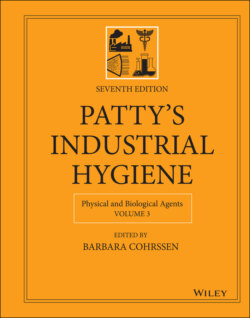Читать книгу Patty's Industrial Hygiene, Physical and Biological Agents - Группа авторов - Страница 102
2.3.2 Measures of Radiation at a Receiving Surface
ОглавлениеIrradiance E is defined as the radiant flux incident per unit area of receiving surface and is measured in watts per square meters. Radiant exposure H is the energy incident per unit area of receiving surface. When spectrally weighted by a photobiologic spectral response function, radiant exposure can be considered the biologically effective dose for that response. The photometric analogue of irradiance is the illuminance, measured in lux (lx), where 1 lx is equal to 1 lm m−2. The photometric analogue of radiant exposure is the light exposure, measured in lux‐seconds.
TABLE 1 Radiometric and photometric terms and units.
| Radiometric term | Radiometric units | Photometric term | Photometric units | Symbol | Defining relationship |
|---|---|---|---|---|---|
| (a) Measures of radiation emitted at source | |||||
| Radiant energy | J | Luminous energy, quantity of light | lm s (talbot) | Q | — |
| Radiant power, radiant flux | W | Luminous flux | lm | Φ | |
| Radiant intensity | W sr−1 | Luminous intensity | cd | I | |
| Radiance | W m−2 sr−1 | Luminance | cd m−2 | L | |
| Radiant exitance | W m−2 | Luminous exitance | lm m−2 | M | |
| (b) Measures of radiation received at surface | |||||
| Irradiance | W m−2 | Illuminance | lx | E | |
| Radiant exposure | J m−2 | Light exposure | lx s | H |
t, time; Ω, solid angle at source; As, area of source; θ, angle relative to source normal; Ar, area of receiving surface; J, joule; lm, lumen; s, second; W, watt; sr, steradian; cd, candela; m, meter; lx, lux.
FIGURE 3 Illustration of radiometric terms and their defining variables. dΩ, differential solid angle at source; dA, differential area cut off by dΩ on surface of sphere of radius r; dΦ, differential radiant flux; dAs, differential area of source; θ, angle relative to source normal.
The radiometric and photometric terms relating to radiation received on a surface are summarized in Table 1 (part (b)).
The irradiance at a distance r from a point source that is emitting a total radiant flux Φ isotropically can be calculated as
This relationship is known as the inverse square law. The inverse square law is not valid within close distances of an area source. However, when the distance from an area source is more than five times greater than the longest dimension of the source, the irradiance does become proportional to the inverse square of the distance from the source (10). Under these circumstances, given a Lambertian source of area As, the radiant flux dΦ received at a differential receiving area dAr is
(7)
where θ is the angle between the line of sight and the perpendicular to the radiating surface, and θr is the angle between the line of sight and the perpendicular to the receiving surface. The solid angle subtended by the differential receiving area is , where the factor cos θr takes account of the fact that the receiving area will subtend a smaller solid angle, and so capture less radiant flux, if it is not oriented perpendicular to the line of sight. The irradiance is then
which is Lambert's cosine law combined with the cosine response of the receiving surface.
